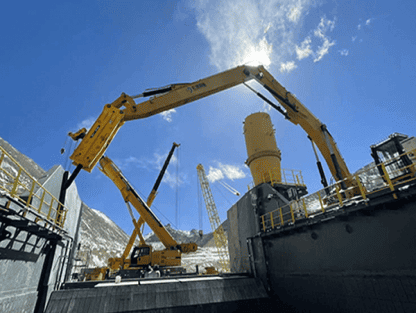Rock breakers play a critical role in a variety of industries, from mining and construction to demolition and quarrying. These machines are indispensable for breaking down large rocks into smaller, manageable pieces, ensuring smooth and efficient operations. Understanding the different types of rock breakers, their applications, and how they integrate with systems like Rockbreaker Boom Systems, stationary rock breakers, and Breaker Booms can help operators choose the right equipment for their needs. In this article, we’ll explore the various types of rock breakers, their unique features, and their benefits.
A rock breaker is a heavy-duty machine or tool designed to break or demolish large rocks into smaller fragments. These machines are commonly used in industries such as mining, construction, and quarrying, where breaking down oversized rocks is a necessary step in processing raw materials. Rock breakers can be manual, hydraulic, or pneumatic, and they come in different forms depending on their intended use.
The type of rock breaker you need depends on the application, the material you’re working with, and the environment. Below are the primary types of rock breakers and their distinctive features:
Hydraulic rock breakers are the most commonly used type of rock breakers. They operate using hydraulic pressure from an excavator or other heavy machinery. These breakers are highly efficient and versatile, making them ideal for various applications.
Hydraulic rock breakers are often paired with Rockbreaker Boom Systems, which enhance their functionality in stationary applications.

Stationary rock breakers are mounted systems designed for continuous operations in fixed locations. They are commonly used in mining and quarrying to handle oversized rocks that cannot be fed into crushers without further size reduction.
Stationary rock breakers are often integrated with Breaker Booms, which allow operators to position the breaker accurately over the material.
A Rockbreaker Boom System is an advanced setup that combines a boom arm with a rock breaker. These systems are typically used in stationary applications, such as in mining or at crusher sites, to break oversized rocks.
Pneumatic rock breakers use compressed air to generate the force needed to break rocks. While less common than hydraulic systems, these breakers are effective for smaller projects and specific applications.
For large-scale projects, explosive rock-breaking methods may be used. This involves using controlled explosions to break apart massive rock formations. While not technically a "machine," explosive rock breaking is an essential method in mining and quarrying.
To better understand how the different types of rock breakers compare, let’s take a closer look at some key features. The table and chart below highlight the efficiency, cost, and applications of various rock breaker systems.
| Type | Efficiency | Initial Cost | Maintenance Cost | Applications |
|---|---|---|---|---|
| Hydraulic Breakers | High | High | Moderate | Demolition, quarrying, mining |
| Stationary Breakers | High | High | Low | Mining, primary crushing |
| Rockbreaker Booms | Very High | High | Low | Crusher stations, underground |
| Pneumatic Breakers | Moderate | Low | Low | Small-scale projects, tunneling |
| Explosive Systems | Very High | Varies | Low | Large-scale mining, excavation |
Integrating the right rock breaker system into your operations can significantly enhance efficiency, reduce costs, and improve safety. Here are some of the key benefits:
When selecting a rock breaker, consider the following factors:
Rock breakers are essential tools in industries that deal with large rocks and hard materials. From hydraulic rock breakers to Rockbreaker Boom Systems and stationary rock breakers, each type has its own unique advantages and applications. Understanding these differences can help operators make informed decisions, ensuring efficient, safe, and cost-effective operations.
By integrating the right rock breaker system, industries can streamline their processes, minimize downtime, and improve overall productivity. Whether you’re working in mining, construction, or demolition, choosing the right equipment is key to success.